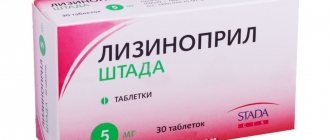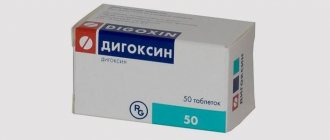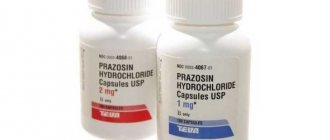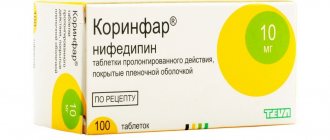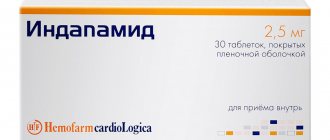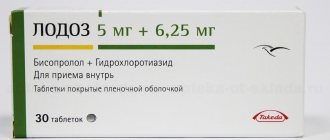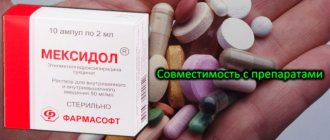pharmachologic effect
Manufacturer: ALSI-pharma, Pranapharm, VERTEKS, Ozone, Russia
Release form: tablets
Active ingredient: Lisinopril
Synonyms: Diroton, Irumed, Lisinoton, Liziprex, Lysigamma, Daprel
The drug belongs to the second generation ACE inhibitors, since it causes a decrease in blood pressure by blocking the formation of the vasoconstrictor factor - angiotensin II.
About the drug
They are tablets for high blood pressure, round in shape and white in color. Contains 5-10-20 mg of the same compound - lisinopril in the form of dihydrate.
According to the pharmacological classification, it is an angiotensin-converting enzyme (ACE) inhibitor. By eliminating the activity of this substance, the amount of angiotensin II and aldosterone, which influence many processes, including an increase in blood pressure, decreases.
Reduces TPVR (total peripheral vascular resistance), arterial hypertension, increases IOC (minute blood volume), increases the resistance of cardiac tissue to stress, dilates blood vessels, improves blood supply to tissues. When the glomeruli are damaged due to diabetic nephropathy, it reduces the concentration of protein in the urine, but does not affect glucose levels.
Lisinopril is prescribed for several pathologies:
- hypertonic disease;
- chronic heart failure (CHF);
- acute myocardial infarction;
- nephropathy due to diabetes mellitus.
The medicine should not be used if there is a risk of developing an allergic reaction, during pregnancy, lactation, or under the age of 18 years. Take tablets with caution if there is a severe impairment of the blood supply to the kidneys, their reduced functional activity, or in old age. The price of Lisinopril varies between 20-200 rubles, it all depends on the region and manufacturer.
Lisinopril analogs
Only a doctor can decide what can replace Lisinopril. Analogs and substitutes for Lisinopril are both synonyms and other ACE inhibitors, such as Fosicard, Hartil and Enalapril.
In addition, there are analogues of Lisinopril without the side effects characteristic of ACE inhibitors. These are adrenergic blockers Anaprilin, Concor and others, as well as sartans - angiotensin antagonists (Lozap, Valsacor, Telzap, Giposart).
Calcium channel blockers, for example, Amlodipine, also reduce blood pressure, and therefore can be considered analogues of the drug Lisinopril, either alone or in combination.
A comparison of the prices of some analogues is given in the table
| A drug | Active substance | Average price for average monthly dose, rub. | Country of origin |
| Lisinopril | Lisinopril | 100 | Russia |
| Diroton | Lisinopril | 300 | Hungary |
| Enalapril | Enalapril | 50 | Russia/India |
| Hartil | Ramipril | 350 | Hungary |
| Lozap | Losartan | 250 | Slovakia |
| Lorista | Losartan | 150 | Slovenia |
| Telzap | Telmisartan | 250 | Türkiye/Russia |
| Phosicard | Fosinopril | 250 | Iceland |
| Concor | Bisoprolol | 300 | Germany |
| Physiotens | Moxonidine | 300 | Germany |
| Perindopril | Perindopril | 200 | Russia |
| Noliprel | Perindopril arginine + Indapamide | 500 | France |
| Captopril | Captopril | 30 | Russia/India |
| Amlodipine | Amlodipine | 80 | Russia |
| Prestarium | Perindopril | 350 | France |
| Valsacor | Valsartan | 300 | Slovenia |
| Indapamide | Indapamide | 30 | Russia |
Hartil
Manufacturer: Egis, Hungary
Release form: tablets
Active ingredient: Ramipril
Synonyms: Amprilan, Tritace, Dilaprel, Vazolong
The analogue of Lisinopril in tablets Hartil is an ACE inhibitor, used for arterial hypertension, treats chronic heart failure, nephropathy and reduces the risk of stroke and myocardial infarction.
Telzap
Manufacturer: Sanofi, Turkey/Russia
Release form: film-coated tablets
Active ingredient: Telmisartan
Synonyms: Mikardis, Praytor, Tanidol, Telmista, Telmisartan-SZ, Telmisartan STADA
The Telzap analogue contains Telmisartan, which is an angiotensin receptor antagonist and also lowers blood pressure and is used for hypertension.
Concor
Manufacturer: Merck, Germany
Release form: film-coated tablets
Active ingredient: Bisoprolol
Synonyms: Biprol, Biol, Bisogamma, Coronal, Niperten
The Concor analogue is a beta-blocker - it lowers blood pressure and has an antianginal and antiarrhythmic effect and is used for hypertension, angina pectoris and arrhythmia.
Phosicard
Manufacturer: Actavis, Iceland
Release form: tablets
Active ingredient: Fosinopril
Synonyms: Monopril, Fosinap, Fosinopril-OBL
The analogue Fosicard is also an ACE inhibitor, has a hypotensive, vasodilating and cardioprotective effect in hypertension and chronic heart failure.
Physiotens
Manufacturer: Solway, Germany
Release form: film-coated tablets
Active ingredient: Moxonidine
Synonyms: Moxonidine-SZ, Moxarel, Moxogamma
The Physiotens analogue is an imidazoline receptor agonist, that is, a centrally acting antihypertensive agent, used only for hypertension, but unlike Lisinopril, it has minimal side effects.
Noliprel
Manufacturer: Servier, France
Release form: film-coated tablets
Active ingredient: Perindopril arginine + Indapamide
The Noliprel analogue is a combination drug consisting of two antihypertensive drugs, which, when used together, enhance the effect of each other.
Used for hypertension and to reduce the risk of vascular complications of diabetes.
ACE inhibitors
The drug "Lisinopril" and its analogues have a pharmacological effect, expressed in the suppression of ACE (angiotensin-converting enzyme) activity. The latter is a natural enzyme included in the extracellular filling of body tissues. It catalyzes the conversion of angiotensin I to angiotensin II, which has a vasoconstrictor effect. Vasoconstriction (vasoconstriction) leads to a decrease in the total working volume of the circulatory system, associated with an increase in blood pressure. In addition, angiotensin II affects the functioning of the heart, changing the heart rate and the force of contraction of the heart muscle.
Pharmacological action of "Lisinopril"
Lisinopril and drugs based on it primarily act as ACE neutralizers. They bind to enzyme molecules, which lose their activity in the formation of angiotensin. A decrease in this hormone has a positive effect on the content of extracellular fluid volume and potassium homeostasis.
Lisinopril and its analogues help increase the level of bradykinin peptide, which has a dilating effect on blood vessels, thereby reducing blood pressure. Taking medications normalizes the protein content in the urine.
The indications for the use of Lisinopril are based on these properties.
- Chronic heart failure developing against the background of ischemic disease and arterial hypertension.
- Myocardial infarction. The drug is used on the very first day of acute development of the disease, as a means of supporting hemodynamics. The medication prevents the development of heart failure and maintains normal functions of the left ventricle of the heart.
- Arterial hypertension.
- Complex damage to the blood vessels of the kidneys in insulin-dependent diabetics (diabetic nephropathy).
The relevance of taking Lisinopril for patients with diabetes lies not only in lowering blood pressure. With the use of the drug, tissue sensitivity to insulin increases, glucose absorption improves, and cholesterol levels decrease.
Pharmaceutical form of release and composition of "Lisinopril"
The drug "Lisinopril" goes on retail sale in tablet form. Each contains 2.5; 5; 10 or 20 grams of the active substance in the form of its dihydrate.
In addition to lisinapril dihydrate, the drug contains excipients and fillers:
1. Mannitol:
- manifests itself as a diuretic, decongestant;
- removes excess fluid from tissue cells into the blood;
- increases total blood volume.
2. Magnesium stearate:
- participates in the normalization of the functions of internal organs (endocrine and digestive systems);
- helps the body absorb calcium;
- promotes blood thinning.
3. Talc. Contains elements necessary for the body (magnesium and silicon).
4. Corn starch. Helps strengthen the nervous system.
The substances that make up Lisinopril, given that the drug is prescribed for a long time of use, have a net positive effect on the body. A small dosage allows you to avoid side effects.
Mode of application
The method of using Lisinopril comes down to the indications that determine the initial dose of the drug, with possible further adjustment. The inhibitory properties of lisinapril-based drugs have a long-lasting effect. Admission is limited to a single daily dose, which can be increased until a lasting expected effect is obtained.
Primary treatment for virtually any disease against which the drug has proven effective begins with one Lisinopril tablet containing the active substance in an amount of 2.5 - 5 mg.
For forms of hypertension that are difficult to treat, the dose of the drug is gradually increased to a maximum of 40 mg. Further expansion is considered inappropriate. The low effectiveness of the drug may require combining the use of an ACE inhibitor with alternative drugs or selecting an appropriate analogue.
For example, "Scopril", in addition to lisinopril (as the main component), contains a diuretic in the form of hydrochlorothiazide. This is just a representative example. It is strictly not recommended to voluntarily switch to medications not prescribed by a doctor. Only a specialist who has complete and reliable information about the patient’s condition decides what can replace or supplement an ineffective drug.
It should also be taken into account that the stabilizing effect of Lisinopril on blood pressure can be judged no earlier than two to three weeks of regular use. Increasing the dose of the drug is also within the competence of the attending physician. The specialist focuses primarily on the patient’s age and the presence of concomitant diseases that require an individual approach.
- In older people, there is a delay in the removal of lisinopril from the body, which can lead to its excessive accumulation. To reduce risks, the initial dose is indicated with the minimum doses of 2.5 mg.
- For patients who have suffered acute myocardial infarction, gentle treatment with this drug with constant monitoring of systolic pressure levels is also recommended. Pressure drop below 90 mm. rt. Art. - indication for o.
- For patients with acute heart failure, the dose of the drug should not exceed 20 mg.
- In patients with renal failure, the quantitative content of the drug for a single dose depends on the creatinine clearance and the results of serum potassium and sodium tests.
The drug is used regardless of diet. Absorption of Lisinopril occurs through the walls of the stomach and small intestine. The maximum content in blood plasma appears after 6 – 7 hours.
Contraindications
For all its positive qualities, Lisinopril and drugs based on it are contraindicated in the following cases:
- intolerance to the drug and its components;
- swelling of the face or limbs associated with an allergic reaction of the body to certain biological and chemical factors (Quincke's edema);
- pregnancy, especially in the second and third trimester;
- breastfeeding;
- patients are under 18 years of age.
Any problems associated with kidney function, heart disease, cerebrovascular accidents, thrombocytopenia require careful use of ACE inhibitors.
Lisinopril or Lozap – which is better?
Manufacturer: Zentiva, Slovakia
Release form: film-coated tablets
Active ingredient: Losartan
Synonyms: Lorista, Cozaar, Bloktran, Losarel, Vero-Losartan, Renicard
Lozap is part of the group of sartans - angiotensin receptor antagonists, due to which, after taking this analogue, angiotensin II ceases to act in the body and blood pressure does not increase.
The Lozap analogue is used not only to lower blood pressure, but also to prevent various cardiovascular diseases accompanied by high blood pressure.
According to reviews, those who take Lozap regularly, their blood pressure stops rising.
Lozap Plus also contains the diuretic component Hydrochlorothiazide, which enhances the hypotensive effect of Losartan and allows you to reduce the therapeutic dose.
Overdose
Saline solution is used to relieve pathological symptoms of drug overdose.
When using the medicine in high doses, an excessive accumulation of Lipril medicinal substances occurs in the body and the patient experiences signs of an overdose. It is indicated by a rapid drop in blood pressure, water-electrolyte imbalance, insufficient kidney function, rapid heartbeat, shock, bradycardia and dizziness. Treatment of overdose is symptomatic and includes intravenous administration of saline solution. In this case, the victim is recommended to lie down and raise his legs up. Immediately after consuming a large amount of lisinopril, gastric lavage, taking enterosorbent and sodium sulfate are effective.
Lisinopril or Enalapril - which is better for blood pressure
Manufacturer: Izvarino, Organika, Ozone, Russia
Release form: film-coated tablets
Active ingredient: Enalapril
Synonyms: Enap, Renipril, Enam, Berlipril, Renitek, Enalapril-ACRI
The analogue Enalapril is included in the same therapeutic group - it is also an ACE inhibitor.
Basically, this is a Russian-made analogue, and Enalapril is the international non-proprietary name of some imported analogues, such as Renitek, Berlipril and other drugs.
According to doctors, Lisinopril is considered more effective than Enalapril, however, it all depends on the individual reactions of the body.
Lisinopril or Lorista – which is better?
Manufacturer: KRKA, Slovenia
Release form: film-coated tablets
Active ingredient: Losartan
Synonyms: Lozap, Cozaar, Bloktran, Losarel, Vero-Losartan, Renicard
The Lorist analogue is used in the same way as Lozap. Protects patients with diabetes from renal failure, is used for heart failure and to prevent high blood pressure.
Reviews from doctors about Lisinopril and Lorist are equally positive; each of these two drugs is popular among cardiologists.
Medicine "Lisinopril": instructions for use
Reviews from patients note that the drug helps stabilize blood pressure in patients with hypertension. It works gradually. Has a cumulative effect.
The drug is taken orally, once a day. The medication is taken regardless of food, at the same time.
For patients with arterial hypertension who do not use other means to lower blood pressure, the drug is prescribed 5 mg per day. If this dosage does not give the required result, then the dose is increased gradually, by 5 mg, every two or three days until the average therapeutic norm is reached, which is 20-40 mg per day. Using a dosage of more than 40 mg per day does not stabilize blood pressure and is hazardous to health. The daily maintenance dose is 20 mg, and the maximum allowed is 40 mg.
The result of treatment with tablets is observed a month after the start of using this medication. If the desired effect was not achieved when using the maximum dose, then it is advisable to use other antihypertensive medications simultaneously with Lisinopril.
If the patient has undergone preliminary therapy with diuretics, then you should stop using these drugs three days before starting to take Lisinopril pills. If the intake of diuretics cannot be stopped, then treatment should be started with 5 mg. In this situation, taking the first dose should be supervised by a doctor, since a sharp decrease in blood pressure sometimes occurs within several hours after taking the medicine.
A low initial dosage of 5 mg is prescribed for renovascular hypertension, as well as for pathologies that increase the activity of the renin-angiotensin-aldosterone apparatus. In this case, the patient should be under close medical supervision when using the medicine. Here it is necessary to monitor the level of blood pressure, the functioning of the renal system, and the presence of potassium ions in the plasma. The maintenance amount of the drug is determined based on the development of the disease.
Before taking tablets, in patients with renal failure, the level of creatinine clearance should be determined. Based on it, the doctor selects an individual dose of medication for the patient. During therapy, it is necessary to monitor the functioning of the kidneys, the amount of sodium and potassium in the blood.
If creatinine clearance is 30-50 ml/min, then you need to start taking the medication with 5-10 mg. At a creatinine level of 10-30 ml/min, the therapeutic course begins with a dosage of 5 mg. This dosage of the drug is also suitable for people resorting to hemodialysis.
If persistent and prolonged arterial hypertension is observed, then the required daily maintenance dose is 10-15 mg. If chronic heart failure is present, then begin the therapeutic course with a dose of 2.5 mg. Over the course of five days, the amount of the drug used is adjusted to 5-10 mg. The daily norm is 20 mg.
The drug is used for myocardial infarction in the acute stage of development. Here it is often used in complex treatment. On the first day, 5 mg is prescribed, a day later - another 5 mg, and after two days - 10 mg. In the following days of therapy, drink 10 mg once a day. The therapeutic course of treatment should last about six weeks or more.
If the pressure drops to 90 mm. rt. Art. for more than an hour, then taking Lisinopril should be stopped.
Persons with type II diabetes mellitus suffering from nephropathy should take the medicine once a day. The dosage can be gradually increased to 20 mg. This is necessary to achieve a diastolic blood pressure of less than 75 mmHg in a sitting position. In persons diagnosed with type 1 diabetes mellitus, the same dosage is used to achieve a diastolic blood pressure of less than 90 mmHg in a sitting position.
Lisinopril or Perindopril
Manufacturer: Izvarino, Pranafarm, Promomed Rus, Russia
Release form: film-coated tablets
Active ingredient: Perindopril
Synonyms: Prestarium, Perineva, Coverex, Parnavel, Perindopril-Vertex, Perindopril-Teva
Perindopril is part of the group of AP inhibitors. Additionally, it reduces heart rate, reduces myocardial oxygen demand, restores vascular elasticity, and has a moderate diuretic effect. Therefore, the use of Perindopril is wider; in addition to hypertension, the drug is prescribed for angina pectoris and for the prevention of complications after strokes.
Accordingly, Perindopril can be considered more effective than Lisinopril.
Lisinopril or Captopril – which is better?
Manufacturer: Pharmakor, Ozone, Biosynthesis, Pranapharm, Russia
Release form: tablets
Active ingredient: Captopril
Synonyms: Capoten, Angiopril, Captopril Sandoz, Captopril-AKOS
Captopril belongs to the very first generation of ACE inhibitors. The drug is quickly absorbed into the bloodstream, the effect occurs within 30 minutes after administration, therefore it is often used as an ambulance for hypertensive crises.
Captopril can be considered the cheapest Russian analogue of Lisinopril.
Why does a dry cough cause?
Why does lisinopril cause dry cough worries many patients, as it causes discomfort in everyday life. This is one of the possible side effects of the drug. According to the teaching, this is determined by the disease that the patient suffers from. Basically, the manifestation of a dry cough is characteristic of people suffering from heart failure. Most of it is associated with taking ACE inhibitors, but it is also possible when taking beta-blockers. This cough is not dangerous, but causes some discomfort.
The cause of dry cough, as evidenced by numerous studies, is an increase in the level of the bradykinin peptide, which has the ability to be cured. In patients, after taking the medicine in tablet form, irritation of the larynx occurs, which leads to an undesirable effect. Lying down makes the cough worse.
Lisinopril or Amlodipine
Manufacturer: Berezovsky pharmaceutical plant, Rozlex, ALSI-pharma, Russia
Release form: film-coated tablets
Active ingredient: Amlodipine
Synonyms: Norvasc, Tenox, Normodipin, Amlotop, Kalchek, Amlorus, Cordi Cor
The analogue Amlodipine reduces blood pressure by another mechanism: the drug is a calcium channel blocker, that is, it reduces the tone of the smooth muscles of the vascular walls.
In addition to the hypotensive effect, Amlodipine increases the supply of oxygen to the myocardium, therefore it is also successfully used as an antianginal agent for angina pectoris.
Lisinopril or Prestarium - which is better?
Manufacturer: Servier, France
Release form: film-coated tablets dispersible in the oral cavity
Active ingredient: Perindopril
Synonyms: Prestarium, Perineva, Coverex, Parnavel, Perindopril-Vertex, Perindopril-Teva
Prestarium is an ACE inhibitor and additionally reduces heart rate, reduces myocardial oxygen demand, restores vascular elasticity, and has a moderate diuretic effect.
Prescribed for coronary heart disease and for the prevention of complications after strokes.
Enap or Lisinopril – which is better?
Manufacturer: KRKA, Slovenia
Release form: film-coated tablets
Active ingredient: Enalapril
Synonyms: Renipril, Enam, Berlipril, Renitek, Enalapril-ACRI
The Enap analogue is a first generation ACE inhibitor. Reduces blood pressure and is used for hypertension and other cardiovascular diseases.
Enap N contains a diuretic component that enhances the effect of the main active ingredient.
Lizoril
One of the analogues of lisinopril is lisoril, which is prescribed by a cardiologist. Also used for diabetic nephropathy. Compared to other inhibitors, this drug has the ability to dilate arteries to a greater extent and veins less. Helps reduce myocardial hypertrophy and arterial walls characterized by resistive type.
Blood flow in the ischemic myocardium improves. There is also a slowdown in the progression of LV dysfunction in patients who have suffered a myocardial infarction without visible clinical symptoms. A stable improvement in patients' health is observed after 1-2 months of taking this medication.
Indapamide or Lisinopril - which is better?
Manufacturer: ALSI-pharma, Ozon, Biokhimik, Russia
Release form: film-coated tablets
Active ingredient: Indapamide
Synonyms: Indap, Arifon, Arifon Retard, Ravel SR, Indapamide Retard
The analogue Indapamide is a diuretic, due to its diuretic effect and lowers blood pressure.
Indapamide is an analogue of Lisinopril without the side effects characteristic of ACE inhibitors.
Before replacing Lisinopril for blood pressure, you should definitely consult a doctor who will help you find a replacement for Lisinopril, taking into account the whole picture of the patient’s disease.
Composition of tablets and their release form
Medicines used to lower and stabilize blood pressure include the drug Lisinopril. The use (reviews note that the medicine is effective, but can cause a number of side effects) of this drug should be carried out only as prescribed by the treating doctor.
This product is produced in tablets, which, depending on the amount of active substance in them, can be:
- dark orange - 2.5 mg;
- orange tint - 5 mg;
- pink – 10 mg;
- white – 20 mg.
The tablets themselves are flat and round, with slightly beveled edges. They are at risk. The blister contains ten tablets. The package contains from 2 to 6 contour cells. The drug is also packaged in fourteen tablets per blister. With this form of production, there are from 1 to 4 contour cells in the package.
The active component of the drug is lisinopril in the form of dihydrate. Additional substances in the pill are:
- corn starch;
- lactose monohydrate;
- methylene chloride;
- magnesium stearate;
- povidone;
- dyes.
The drug is produced by both foreign and Russian pharmaceutical companies. Depending on the manufacturer, the composition of minor components may vary.
